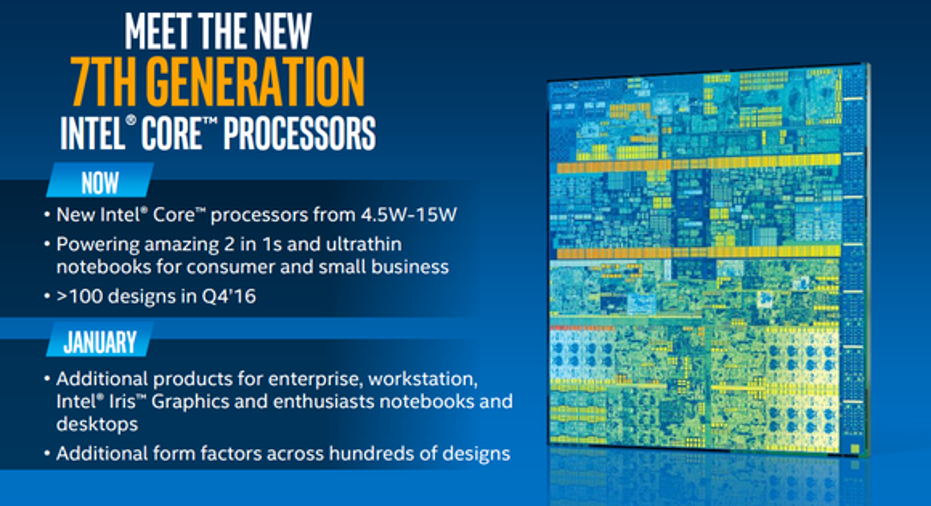Intel Corporation May Have Canceled a Significant Product

Image source: Intel.
Back in 2013, microprocessor giant Intel (NASDAQ: INTC) released a series of chips based on its Haswell architecture (fourth-generation Core) with a graphics technology known as Iris Pro. This graphics technology made the chip larger and more expensive to make than the variants without Iris Pro, but performance in graphically intensive applications such as 3D games went up significantly.
For the right customers, such as Apple (NASDAQ: AAPL), the product family made sense.
Intel followed up the original Haswell-based Iris Pro chips with variants of its Broadwell (fifth-generation Core) and Skylake (sixth-generation Core) architectures that included updated versions of the Iris Pro technology.
An early leak suggested that Intel also planned to introduce an Iris Pro-powered variant of its Kaby Lake architecture (seventh-generation Core). However, I believe that it is very likely that this product has been canceled.
Sifting for clues
In a product brief that Intel posted alongside the announcement of its seventh-generation Core processor family, it included the following slide:
Image source: Intel.
Notice that Intel says that in January it will launch "additional products for enterprise, workstation, Intel Iris Graphics and enthusiasts [sic] notebooks and desktops." Note that Intel didn't say Iris Pro here, just vanilla Iris Graphics (a type of high-performance graphics included in Intel's lower-power notebook processors; Iris Pro is for higher-performance/power chips).
Although the above should be enough to raise the proverbial yellow flag, there's even more evidence.
Take, for example, a recent leak from NotebookCheck.net, of what looks like an Intel internal slide showing the launch timelines for each of the seventh-generation Core processors. It lists the following chip variants:
- U 2+2 (HDCP 1.4)
- U 2+2 (HDCP 2.2)
- S 4+2 (HDCP 2.2)
- H 4+2 (HDCP 2.2)
- U 2+3e (HDCP 2.2)
- S 2+2 (HDCP 2.2)
Don't worry too much about the specifics, but a seventh-generation Core processor with Iris Pro graphics would have been an 'H' series processor (high-performance notebook) in a 4+4e configuration (four processor cores + GT4 graphics + eDRAM). This configuration is absent from this particular leak.
If that weren't enough, there's still even more evidence. NotebookCheck.net also got its hands on another image that appears to be from Intel, showing the company's planned seventh-generation Core processor product stack. Unsurprisingly, it, too, lacks a 4+4e part.
The future of Iris Pro remains unclear
Intel's Iris Graphics processorsin low-power laptops appear to be doing well and are gaining momentum, something that should serve to enrich the company's notebook product mix. This makes sense, as an integrated graphics solution is generally preferable for size and battery life in the kinds of laptops that would use either a 15-watt or 28-watt processor.
Iris Pro, on the other hand, doesn't seem to have been as successful. Apple's current 15-inch MacBook Pro still uses fourth-generation Core-based Iris Pro processors. Very few notebook vendors seemed to adopt Intel's fifth-generation Core processors with Iris Pro (though Apple's 21.5-inch iMac uses such a chip), and I can't find any notebooks with Intel's sixth-generation Core processors with Iris Pro (even though Intel's product page says that such products have been launched).
Customer demand for Intel processors with Iris Pro graphics may simply not be there, particularly as the high-performance laptops that Iris Pro would be suitable for can generally support stand-alone graphics processors without much issue. And, if personal computer manufacturers are, by and large, not interested, then it makes little sense for Intel to invest further in that product line (especially in light of the company's recent restructuring actions).
I think the big "tell" for whether Iris Pro has a future will be the processor Apple uses when it updates the 15-inch MacBook Pro (rumored for later this year). If Apple uses a chip with Iris Pro, then the technology may have a future. If Apple simply uses a quad-core chip with GT2 graphics (in other words a "4+2" configuration) in the system, then it may be "game over" for Iris Pro.
A secret billion-dollar stock opportunity The world's biggest tech company forgot to show you something, but a few Wall Street analysts and the Fool didn't miss a beat: There's a small company that's powering their brand-new gadgets and the coming revolution in technology. And we think its stock price has nearly unlimited room to run for early in-the-know investors! To be one of them, just click here.
Ashraf Eassa owns shares of Intel. The Motley Fool owns shares of and recommends Apple. The Motley Fool has the following options: long January 2018 $90 calls on Apple and short January 2018 $95 calls on Apple. The Motley Fool recommends Intel.
Try any of our Foolish newsletter services free for 30 days. We Fools may not all hold the same opinions, but we all believe that considering a diverse range of insights makes us better investors. The Motley Fool has a disclosure policy.



















